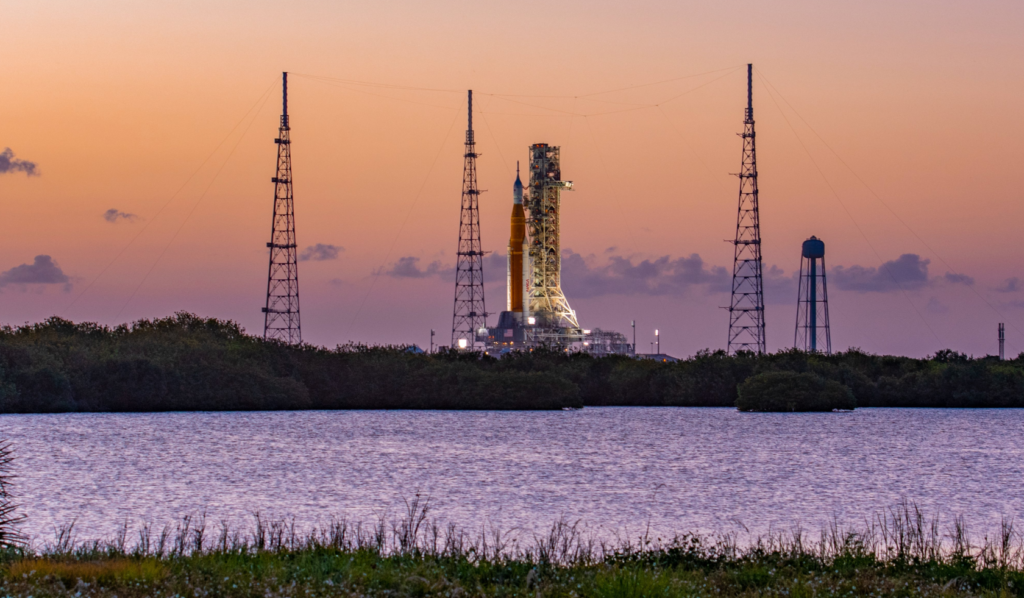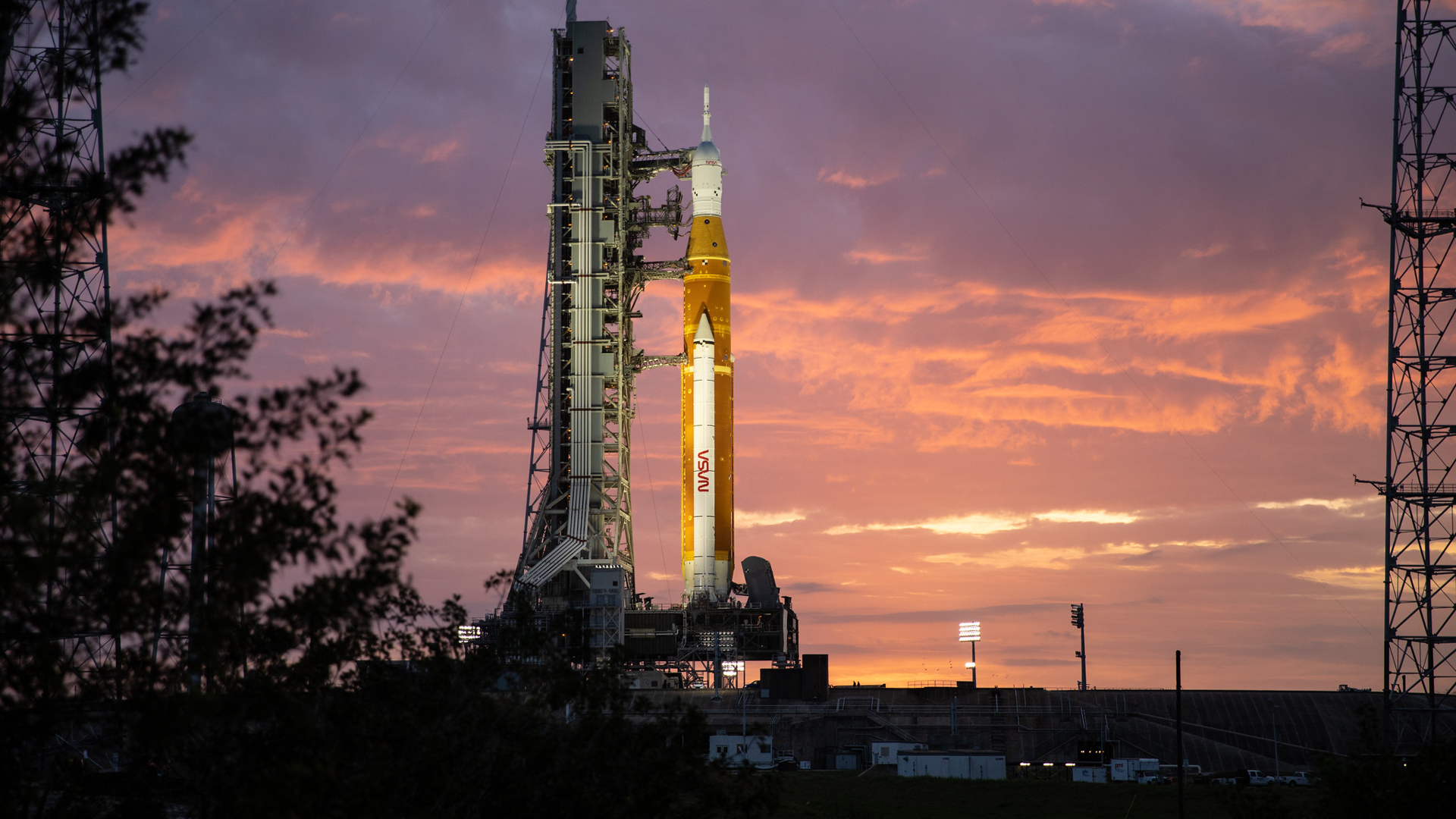
How Are Repairs Going On The Space Launch System?
Many of us have been keeping track of NASA’s progress as they get closer and closer to returning humans to the surface of the Moon. The Artemis program is the backbone of these missions and has many different important aspects to it. One of which is SLS or the Space Launch System, one of the most powerful rockets in the world meant to transport astronauts to the Moon and back.
If you have been watching SLS’s progress you will have seen the recent wet dress rehearsal attempts. This test was intended to take just a few days but by now it has passed the month-long mark. Over the course of April, this test exposed a few problems with the launch vehicle and various ground systems. Due to these problems, NASA moved SLS back to the VAB for repairs. They recently gave updates regarding the time frame of the rocket and when to expect the test to be finished.
Once this wet dress rehearsal is complete one of the next steps is the first-ever launch attempt with an uncrewed Orion capsule and SLS rocket. However, before this important launch happens, NASA needs to make sure everything is perfect and ready. Here I will go more in-depth into the recent progress, repairs, expected timelines, and more.
SLS Repair Progress

After very eventful first attempts for the wet dress rehearsal, the launch vehicle was returned to the VAB for multiple repairs. The plan is to fix these problems that were presented and then return SLS to the launch pad to continue the wet dress rehearsal. Over the past few days, NASA has been making progress on these goals. One of the first updates regarding the repairs was released just over a week ago in late April. Specifically, on April 28, NASA tweeted saying “Moon Rocket Check-In: Views from today of @NASA_SLS & @NASA_Orion in High Bay 3 of the VAB. Teams extended work platforms to work on replacing a faulty upper stage check valve, a small leak within the tail service mast umbilical ground plate housing, and additional check outs.” The most recent update was only tweeted yesterday and mentioned, “Moon Rocket Update: Teams have replaced a faulty helium check valve on the interim cryogenic propulsion stage (ICPS) and performed tests to address a hydrogen leak on a tail service mast umbilical between the mobile launcher and @NASA_SLS.” It seems like NASA is confident in the fix for the helium check valve and still working on the hydrogen leak issue.
Taking a closer look, since returning to the Vehicle Assembly Building, ground systems teams have worked to prepare the Artemis I Space Launch System rocket and Orion spacecraft to roll back to Launch Pad 39B in late May to complete the wet dress rehearsal test in the early to mid-June timeframe. Inside the VAB at NASA’s Kennedy Space Center, engineers replaced a faulty helium check valve on the interim cryogenic propulsion stage that was identified after the second wet dress rehearsal attempt. In early April, Engineers identified a helium check valve that was not functioning as expected, requiring changes to ensure the safety of the flight hardware. Helium is used for several different operations, including purging the engine, or clearing the lines, prior to loading propellants during tanking, as well as draining propellant. A check valve is a type of valve that allows liquid or gas to flow in a particular direction and prevents backflow. The helium check valve is about three inches long and prevents the helium from flowing back out of the rocket. Very recently, engineers have inspected the valve and found a small piece of rubber that prevented the valve from sealing correctly. Teams are looking at possible sources of the debris, but did not see any issues with the valve itself, and plan to test the newly installed valve later this week to confirm it is operating as expected.
Engineers also performed tests to address a hydrogen leak on one of two tail service mast umbilicals between the mobile launcher and the rocket. These umbilicals provide liquid oxygen and liquid hydrogen propellants, as well as electrical connections, from the mobile launcher to the rocket’s core stage during the launch countdown. Similar to the previous issue, around mid April teams concluded the wet dress rehearsal test at approximately 5:10 p.m. EDT after observing a liquid hydrogen (LH2) leak on the tail service mast umbilical, which is located at the base of the mobile launcher and connects to the rocket’s core stage. The leak was discovered during liquid hydrogen loading operations and prevented the team from completing the test. Over the past few days, teams conducted leak checks on all the joints and tightened several flange bolts, or fasteners that act as a washer to increase the compression strength, that can loosen over time and were the most likely source of the leak. Teams re-tightened the flange bolts on the liquid hydrogen, liquid oxygen, and core stage intertank umbilicals. Engineers have not detected leaks in subsequent testing at ambient air temperature, and will continue to monitor for leaks when loading the super cold propellants at the launch pad.
In addition, the supplier that provides gaseous nitrogen for operations during tanking is upgrading its facility to meet the requirements for the next wet dress rehearsal attempt and the Artemis I launch. Teams are on track to complete the work early next week, followed by testing to ensure the system is ready for tanking. During the test, teams pump gaseous nitrogen into dry structures to protect avionics during propellant loading.
Future of SLS

Now that we know more about the current complications and solutions with the Space Launch System and various ground systems, we can take a closer look at what to expect in the future. NASA points out that once all major work is completed, teams will retract the working platforms and prepare the integrated SLS rocket and the Orion spacecraft for the second journey to the launch pad. NASA will announce dates for roll to the pad and the next WDR attempt once work is nearing completion inside the VAB. This being said, there are a few estimates we can make. First, in a recent update from NASA, they said the plan is to roll back to Launch Pad 39B in late May to complete the wet dress rehearsal (WDR) test in the early to mid-June timeframe. This gives us a few important dates including when they expect to return to the pad. The estimate of late May means NASA is going to still be making repairs over the next few weeks. If everything goes according to plan we will likely see the Space Launch System rolling back to the pad for a second time to continue testing. However, if issues like the hydrogen leak on the tail service mast umbilical prove more difficult to fix than expected, we might be waiting past May for SLS to return to the pad.
The other date that is mentioned is completing the wet dress rehearsal in early to mid-June. If SLS does finish repairs in late may this timeframe is realistic. This is only the case if the wet dress rehearsal in the month of June goes very smoothly and avoids all the different issues we saw in April. Assuming all of which goes according to plan and the wet dress rehearsal is complete in mid June, we could still see the first orbital test flight with SLS this summer. In a recent call NASA had with reporters on May 5th, it was mentioned that the likely earliest timeframe for Artemis 1 would be in August. However, NASA officials were hesitant to predict a date for the first launch until the wet dress rehearsal was fully complete. Artemis I, formerly Exploration Mission-1, will be the first integrated test of NASA’s deep space exploration systems: the Orion spacecraft, Space Launch System (SLS) rocket and the ground systems at Kennedy Space Center in Cape Canaveral, Florida. The first in a series of increasingly complex missions, Artemis I will be an uncrewed flight test that will provide a foundation for human deep space exploration, and demonstrate our commitment and capability to extend human existence to the Moon and beyond. It would be very exciting to see SLS take flight this summer. In order for this to happen NASA has to make some fast progress in the coming months.
Conclusion
It has been around half a century since the last time a human stepped foot on the Moon. Thankfully, NASA plans to change this with the Artemis missions. One of the key aspects of these missions involves SLS or the Space Launch System. This is one of the most powerful rockets in the world planned to transport humans to and from the Moon. Over the past few weeks going back to the beginning of April, NASA has been working on the wet dress rehearsal for this rocket. However, this test originally expected to only take a few days has been very eventful for the wrong reasons. This has presented a few different errors and things the agency needs to fix. Recently SLS was rolled back into the VAB for repairs. As of right now, NASA is progressing to fix the different issues so they can bring the Space Launch System back to the pad to finish the test. We will have to wait and see how it progresses and the impact it has on the space industry.
